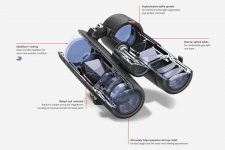From what I learned in photography, optics with identical specifications (magnification and exit pupil) should have the exact same depth of field (DoF), and that largely no other factor affects this, meaning that it is physically impossible for one manufacturer to produce optics with "better" depth of field than those of another (assuming the main general specs are the same).
There are a few caveats though:
1. It's possible that lenses with very high light transmission cause the pupil to shrink slightly, which in turn causes the perceived DoF to increase compared to less bright binoculars (pupil serves as aperture in a photographic lens, and the smaller the pupil, the sharper the image depthwise).
2. The character of the out of-of-focus background ("bokeh") may be different -- some optics may produce out-of-focus backgrounds that look "creamy" (high-quality photographic lenses do this), which causes the viewer to perceive DoF rendering as shallow, while other optics may produce out-of-focus backgrounds that look "busy" (cheaper photographic lenses do this), which causes the viewer to perceive DoF rendering as deep (while in fact in both cases, the DoF is exact same).
3. Optics with a large sweet spot may have different perceived (emphasis on perceived) DoF compared to optics with small sweet spot. For example, I consistently notice that my 10x42 NLs have better apparent DoF than my 8x33 Kowas (roughly similar exit pupil), which is counter-intuitive because normally it is the higher magnification optics that have shallower DoF. I attribute this to larger sweet spot in the NLs which tricks my brain a bit into thinking they have great DoF.





